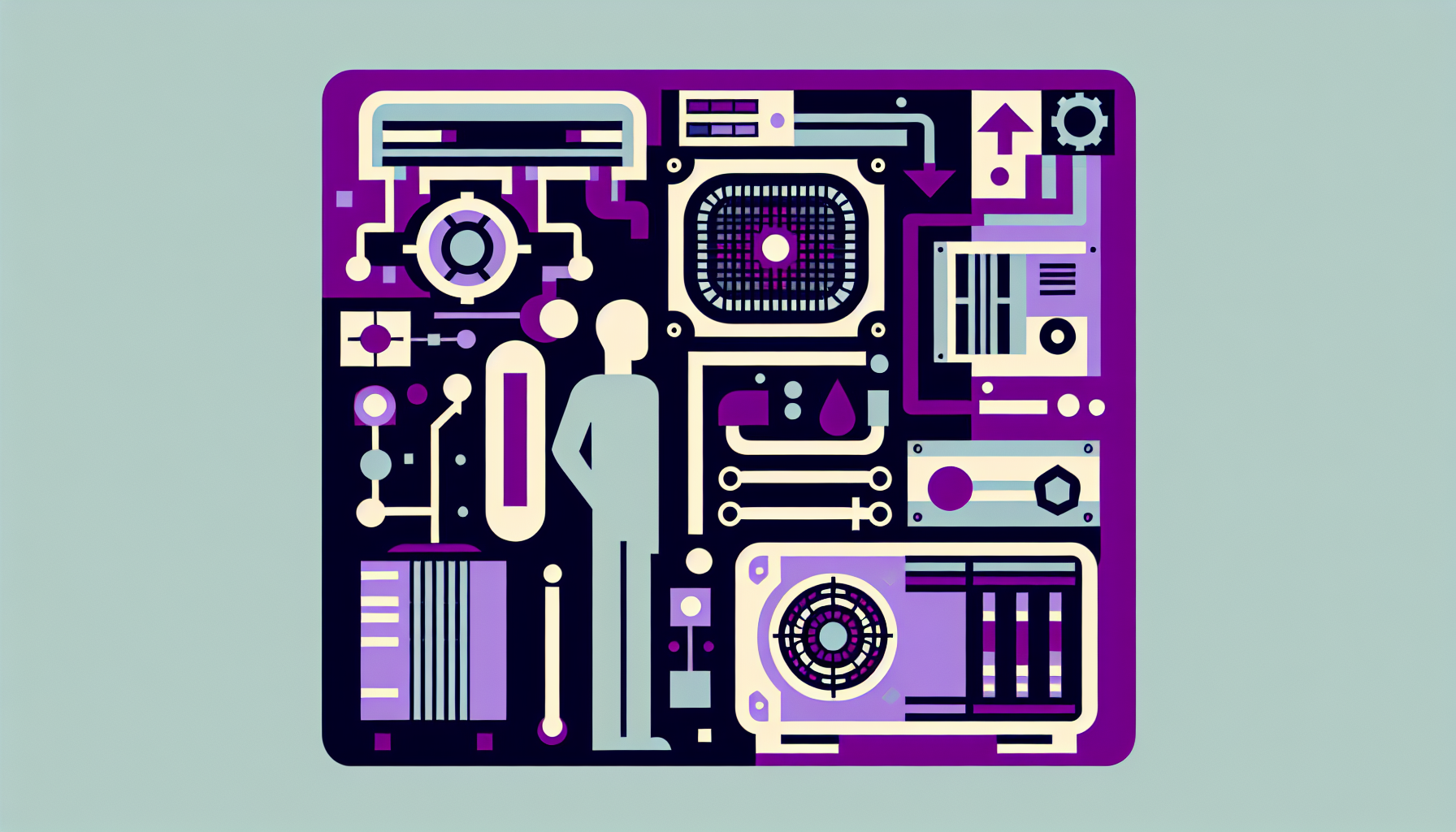Are you looking to optimize your HVAC business operations? Learn how to implement HVAC dispatch software in this comprehensive guide. HVAC dispatch software offers a range of benefits for businesses, including improved coordination of maintenance contracts, installation projects, and emergency repairs. By automating daily processes and providing access to customer information, parts, and invoicing, implementing HVAC dispatch software can increase productivity, improve customer service, and boost revenue. Let’s dive into the step-by-step process of implementing HVAC dispatch software for your business.
Key Takeaways:
- Implementing HVAC dispatch software streamlines HVAC business operations.
- HVAC dispatch software automates daily processes and provides access to customer information, parts, and invoicing.
- Implementing HVAC dispatch software can increase productivity, improve customer service, and boost revenue.
- The implementation process involves four phases: discovery, configuration, validation & go-live, and success.
- Each phase requires customization, training, and support from the software provider.
Understanding the Benefits of HVAC Dispatch Software
HVAC dispatch software offers numerous benefits for your business, from automating processes to enhancing customer service. This software is designed specifically for HVAC businesses, allowing them to coordinate activities such as maintenance contracts, installation projects, and emergency repairs seamlessly.
One of the key advantages of HVAC dispatch software is its ability to automate daily processes. With this software, you can easily schedule and assign jobs, track technicians’ locations, and monitor progress on ongoing projects. These automated features save time and reduce human errors, enabling your business to operate more efficiently.
In addition to process automation, HVAC dispatch software provides you with instant access to customer information, parts, and invoicing. This quick and easy access ensures that your technicians have all the necessary details and resources to complete their jobs effectively. It also enables you to provide accurate and timely information to customers, improving their overall experience with your business.
Implementing HVAC dispatch software can have a significant impact on your business. By streamlining operations, improving customer service, and increasing productivity, you can drive revenue growth and gain a competitive edge in the HVAC industry. With the right software provider, you can seamlessly transition to using dispatch software and start reaping these benefits for your business.
| Benefits of HVAC Dispatch Software |
|---|
| Process automation |
| Efficient job scheduling and assignment |
| Real-time tracking of technicians’ locations |
| Improved customer service |
| Quick access to customer information and parts inventory |
| Accurate and timely invoicing |
| Increased productivity |
| Revenue growth |
The Four Phases of Implementing Dispatch Software
To successfully implement dispatch software, businesses should follow a four-phase approach, including discovery, configuration, validation & go-live, and success. Each phase plays a crucial role in ensuring a smooth and efficient transition to using HVAC dispatch software. Let’s explore each phase in more detail:
Phase 1: Discovery
In the discovery phase, businesses identify their specific requirements and evaluate different dispatch software tools available in the market. It is essential to select the top dispatch software that aligns with the unique needs of the HVAC business. This phase involves researching different options, comparing features and functionalities, and gaining a comprehensive understanding of how the software can enhance business operations.
Phase 2: Configuration
Once the dispatch software is selected, the configuration phase begins. During this phase, the software is customized and integrated with existing systems to meet specific business needs. It is crucial to maximize the available features and functionalities of the software by tailoring it to the HVAC business’s unique workflows and processes. Proper configuration ensures a seamless integration with existing systems and maximizes the software’s potential.
Phase 3: Validation & Go-live
The validation & go-live phase involves thorough testing and validation of the dispatch software before it is implemented in the live environment. Businesses should conduct comprehensive testing to ensure the software works as intended and addresses the specific needs of the HVAC business. Additionally, proper training should be provided to employees to ensure a smooth transition to using the new software. This phase is critical to identify any issues or challenges before going live and to ensure a successful implementation.
Phase 4: Success
The success phase focuses on measuring the impact of the implemented dispatch software and evaluating its benefits. Businesses should continuously monitor and analyze key metrics to measure the software’s effectiveness in improving productivity, customer service, and revenue. Ongoing support from the software provider is crucial during this phase to address any questions or issues that may arise. Continuous improvement and adaptation are necessary to achieve long-term success with HVAC dispatch software.
| Phase | Description |
|---|---|
| Discovery | Identify business requirements, evaluate dispatch software tools, and select the top dispatch software. |
| Configuration | Customize the dispatch software, integrate it with existing systems, and maximize available features. |
| Validation & Go-live | Thoroughly test and validate the dispatch software, provide training, and ensure a smooth transition to the live environment. |
| Success | Measure the impact of the implemented software, evaluate benefits, and ensure ongoing support and improvement. |
Phase 1: Discovery
In the discovery phase, businesses should assess their requirements, explore available dispatch software tools, and pinpoint the top dispatch software solution. This phase is crucial as it sets the foundation for successful implementation. By thoroughly understanding their needs and evaluating various options, businesses can make informed decisions and choose the dispatch software that best aligns with their specific needs.
During the discovery phase, it is essential to identify the key pain points and challenges that the dispatch software needs to address. This could include streamlining scheduling processes, improving communication with technicians, or enhancing customer service. By conducting a thorough analysis of the current operations, businesses can identify areas for improvement and determine the functionalities required in the dispatch software.
To explore available dispatch software tools, businesses can refer to industry research, consult with industry experts, or attend trade shows and exhibitions. It is important to compare different software solutions based on their features, ease of use, scalability, and compatibility with existing systems. By shortlisting the top dispatch software options, businesses can proceed to the next phase of the implementation process.
Table: Top Dispatch Software Comparison
| Software | Features | Scalability | Compatibility |
|---|---|---|---|
| Dispatch Pro | Real-time scheduling, mobile app, reporting | Highly scalable | Integrates with existing CRM systems |
| ServiceM8 | Job management, quoting, invoicing | Scalable for small to medium-sized businesses | Seamless integration with Xero and QuickBooks |
| FieldEdge | Dispatching, GPS tracking, customer history | Scalable for HVAC businesses of all sizes | Integrates with popular accounting software |
By carefully evaluating the available dispatch software tools and considering their features, scalability, and compatibility, businesses can confidently select the top dispatch software that will effectively streamline their HVAC operations.
Phase 2: Configuration
The configuration phase focuses on customizing the dispatch software, integrating it with existing systems, and leveraging its various features. This step is crucial in ensuring that the software meets the specific needs of your HVAC business. By tailoring the software to your requirements, you can optimize its functionality and enhance your overall efficiency.
During the configuration phase, it is important to collaborate closely with the software provider. They will guide you through the process of setting up the software and assist you in mapping your existing workflows onto the new system. By aligning the software with your current processes, you can minimize disruption and maximize productivity.
Integrating the dispatch software seamlessly with your existing systems is another key aspect of the configuration phase. This enables efficient data transmission and ensures that information can flow seamlessly across different platforms. By integrating the software, you can centralize your data and eliminate the need for manual data entry, reducing errors and saving time.
In addition to customization and integration, the configuration phase also involves exploring and utilizing the various features of the dispatch software. These features may include automated scheduling, real-time monitoring, and inventory management. By leveraging these features, you can streamline your operations, improve communication with technicians, and optimize resource allocation.
| Key Tasks in the Configuration Phase |
|---|
| Customize the software to align with your business processes |
| Integrate the dispatch software with existing systems |
| Explore and utilize the various features of the software |
By carefully configuring the dispatch software, you can lay the foundation for a successful implementation. This phase sets the stage for the next steps, ensuring that the software is tailored to your business requirements and ready to streamline your HVAC operations.
Phase 3: Validation & Go-live
Before going live, businesses must validate the dispatch software, conduct extensive testing, and provide comprehensive training to employees. This phase is crucial to ensure a smooth transition and minimize disruptions to daily operations.
To validate the dispatch software, businesses need to compare the system’s performance with their specific requirements and expectations. This involves conducting thorough testing to ensure that all functionalities and integrations work as intended. Any identified issues or discrepancies should be addressed promptly, either by the software provider or through internal troubleshooting.
During the validation process, it is essential to involve all key stakeholders, including dispatchers, technicians, and management. This will ensure that everyone understands how the new software works and can provide valuable feedback for further improvements. Comprehensive training should be provided to employees to ensure they are familiar with the software’s features, navigation, and data entry procedures.
Once the dispatch software has been validated and employees are trained, the go-live phase can be initiated. This involves migrating all necessary data, such as customer information, service history, and inventory data, into the new system. It is important to carefully plan and execute this data migration process to minimize data loss or duplication. By following these steps, businesses can successfully implement the dispatch software and optimize their HVAC operations.
| Phase 3: Validation & Go-live | Key Steps |
|---|---|
| 1 | Validate the dispatch software by comparing its performance with specific requirements |
| 2 | Conduct thorough testing to ensure all functionalities and integrations work properly |
| 3 | Address any identified issues or discrepancies promptly |
| 4 | Involve key stakeholders and provide comprehensive training to employees |
| 5 | Migrate necessary data into the new dispatch software system |
Phase 4: Success
The success phase involves measuring the benefits of the implemented dispatch software, ensuring ongoing support, and striving for continuous improvement. It is crucial to evaluate the impact of the dispatch software on your HVAC business operations. Assess key performance indicators such as increased efficiency, reduced response time, and improved customer satisfaction. This data will help you understand the software’s effectiveness and identify areas for further enhancement.
During this phase, ongoing support from the software provider plays a vital role. They can address any questions or concerns that arise and provide guidance on optimizing the use of the software. Take advantage of the available resources, such as training sessions, webinars, and user forums, to enhance your team’s proficiency and maximize the benefits of the software.
Additionally, it is essential to strive for continuous improvement. Regularly review and analyze your HVAC business processes and identify any areas that can be further streamlined or optimized. Take advantage of new updates and features released by the software provider to stay up-to-date with the latest advancements. By embracing a culture of continuous improvement, you can ensure that your HVAC dispatch software remains a valuable tool for your business for years to come.
| Phase 4: Success Tips |
|---|
| 1. Regularly measure and analyze key performance indicators to evaluate the benefits of the dispatch software implementation. |
| 2. Take advantage of ongoing support from the software provider to address any questions or concerns. |
| 3. Engage in training sessions, webinars, and user forums to enhance your team’s proficiency. |
| 4. Continuously review and optimize your HVAC business processes to further streamline operations. |
| 5. Stay updated with new updates and features released by the software provider to maximize benefits. |
Ongoing Support and Troubleshooting
Ongoing support from the software provider is crucial during and after the dispatch software implementation process to address any questions or issues that may arise. As you transition to using HVAC dispatch software, it’s important to have a reliable support system in place to ensure a smooth experience.
The software provider should offer a dedicated support team that can assist you with any technical difficulties or operational challenges. They should be responsive and accessible, providing timely solutions to keep your business running smoothly. Whether you have questions about software functionality, need assistance with customization, or encounter any issues, the support team should be there to guide you every step of the way.
In addition to ongoing support, the software provider should also offer troubleshooting services. This means they will help you identify and resolve any problems that may occur during the implementation process or while using the dispatch software. They should have a thorough understanding of the software and be able to troubleshoot common issues effectively.
Table: Common Dispatch Software Issues and Solutions
| Issue | Solution |
|---|---|
| Difficulty configuring software settings | The support team can provide step-by-step guidance and assistance with configuration to ensure optimal software performance. |
| Data synchronization problems | The support team can help troubleshoot data synchronization issues and provide solutions to ensure accurate and up-to-date information. |
| Integration challenges with existing systems | The support team can work with your IT department to ensure seamless integration and address any compatibility issues. |
| Software performance slowdowns | The support team can diagnose performance issues and provide recommendations to optimize software performance and speed. |
With the right ongoing support and troubleshooting measures in place, you can have peace of mind knowing that any issues or questions you encounter will be addressed promptly, allowing you to maximize the benefits of your HVAC dispatch software.
Conclusion
By following this step-by-step guide, you can smoothly implement HVAC dispatch software and unlock its benefits for your business. HVAC dispatch software offers numerous advantages, such as automating daily processes, providing access to customer information, and improving customer service. With the ability to coordinate maintenance contracts, installation projects, and emergency repairs, this software streamlines operations and increases productivity.
The implementation process consists of four phases: discovery, configuration, validation & go-live, and success. During the discovery phase, it is crucial to identify your business requirements and select the top dispatch software that aligns with your specific needs. In the configuration phase, customization plays a vital role in adapting the software to meet your business requirements while maximizing its features and integrating it with existing systems.
Once the software has been configured, the validation & go-live phase involves thorough testing, employee training, and ensuring a smooth transition to the new system. The success phase focuses on measuring the impact and benefits of the implemented dispatch software. Continuous improvement and ongoing support from the software provider are essential to achieve long-term success.
Throughout the implementation process and beyond, ongoing support and troubleshooting are available to address any questions or issues that may arise. By embracing HVAC dispatch software and leveraging its capabilities, your business can enhance efficiency, improve customer satisfaction, and ultimately drive revenue growth.
FAQ
What are the benefits of using HVAC dispatch software?
HVAC dispatch software offers several benefits, including streamlining daily processes, automating tasks, accessing customer information, and improving customer service.
How can implementing HVAC dispatch software increase productivity?
By automating processes, providing access to relevant information, and optimizing scheduling, HVAC dispatch software helps businesses increase productivity and efficiency.
Can HVAC dispatch software help improve customer service?
Yes, HVAC dispatch software enables businesses to efficiently handle customer requests, provide real-time updates, and deliver a more personalized service experience.
What are the four phases of implementing HVAC dispatch software?
The four phases are discovery, configuration, validation & go-live, and success. Each phase involves customization, training, and support from the software provider.
What happens during the discovery phase of HVAC dispatch software implementation?
The discovery phase focuses on identifying business requirements, evaluating software tools, and selecting the most suitable HVAC dispatch software solution.
What does the configuration phase of implementing dispatch software involve?
In the configuration phase, the dispatch software is customized to meet specific business needs, including integrating with existing systems and utilizing available features.
What happens during the validation & go-live phase of implementing dispatch software?
The validation & go-live phase involves testing and validating the dispatch software before launching it live. It also includes employee training and ensuring a smooth transition.
How can businesses measure success after implementing HVAC dispatch software?
Success can be measured by evaluating the impact on productivity, customer satisfaction, and revenue. Ongoing support and continuous improvement are also essential for long-term success.
Is ongoing support available for businesses implementing HVAC dispatch software?
Yes, ongoing support is provided by the software provider to address any questions or issues that arise during and after the implementation process.





0 Comments